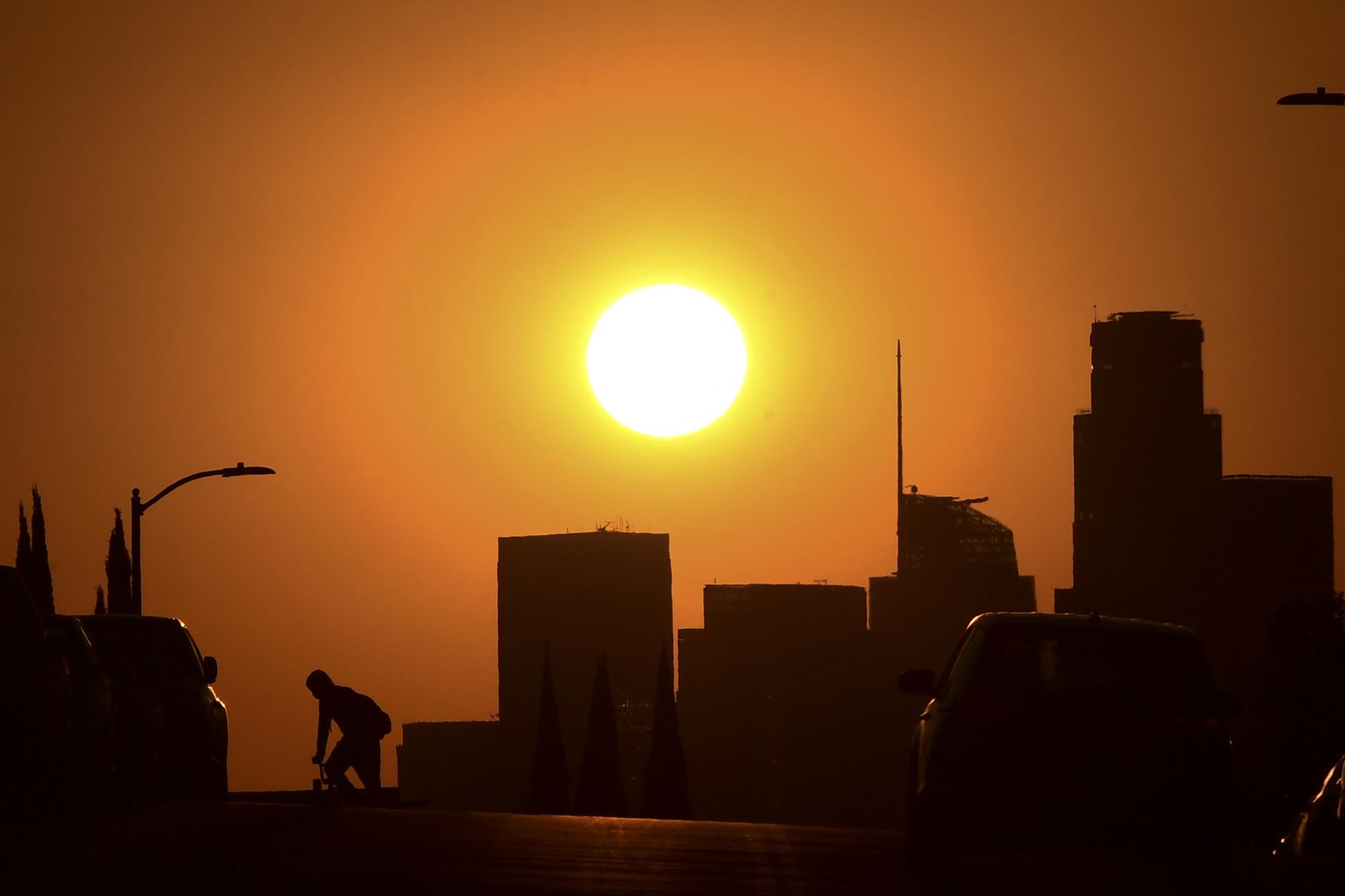
As California heads into a dangerous holiday heat wave that will blanket millions of residents in triple-digit temperatures, state and federal officials are vowing to do more to address the worsening threat — and the rising costs — of extreme heat.
On Tuesday, the U.S. Department of Labor’s Occupational Safety and Health Administration, or OSHA, announced that it will advance a proposed rule to protect indoor and outdoor workers from high temperatures at the national level. If finalized, the regulations would establish temperature-based standards for an estimated 35 million workers in places such as warehouses, kitchens, farms and construction sites.
The proposal, which has been in the works since 2021, would apply to workplaces where the heat index regularly rises above 80 degrees, according to senior administration officials. It would follow similar moves by California, which in 2006 became the first state in the nation to establish permanent heat protections for outdoor workers and just last month approved heat regulations for indoor workers.
Officials said such rules are needed as extreme heat claims more lives and as the nation grapples with more frequent and severe weather events fueled by climate change. Last year, the U.S. saw a record 28 disasters that exceeded $1 billion in losses, which caused more than $90 billion in aggregate damage.
Aggressive and impactful reporting on climate change, the environment, health and science.
At the same time, California’s Department of Insurance this week released a first-of-its kind analysis revealing $7.7 billion in insurance losses tied to extreme heat events over the last decade. The report quantifies the uninsured and insured costs of seven recent extreme heat events in the state and highlights the need for adaptive strategies.
It joins a growing body of evidence about extreme heat’s toll — from mounting heat-related illnesses and fatalities to biodiversity impacts, economic effects, agricultural losses and infrastructure damage. Heat has contributed to more deaths over the last 30 years than hurricanes, floods and tornadoes combined, making it the deadliest of all U.S. climate hazards, according to the National Weather Service. Last year was the planet’s hottest year ever recorded.
“Extreme heat is a silent, escalating disaster that threatens our health, economy, and way of life in California,” read a statement from Insurance Commissioner Ricardo Lara. “This report brings to light the staggering hidden costs of extreme heat events, underscoring the urgency of our efforts to create a groundbreaking heat wave ranking and early warning system statewide. We must prioritize resilience-building efforts and innovative insurance solutions to safeguard our state against the growing impacts and financial risks of extreme heat.”
California’s longest heat wave of the year, bringing triple-digit temperatures, fire danger and air quality concerns, is expected to arrive Tuesday.
Indeed, experts have for years been pushing for more stringent surveillance of heat’s toll, with a 2021 Los Angeles Times investigation revealing that extreme heat deaths are chronically undercounted in the state. Following that investigation, Gov. Gavin Newsom signed into law a bill to create a heat wave ranking system similar to those used for hurricanes. The system is slated to be in place by Jan. 1, 2025.
Newsom also in recent years launched an extreme heat awareness campaign, urban greening programs and other efforts to help residents prepare for and adapt to worsening heat; however some of those programs received cuts amid this year’s budget deficit.
Though the $7.7-billion cost associated with heat events is substantial, the Department of Insurance estimated that the true toll is likely higher. While some kinds of insurance do cover costs connected to extreme heat — such as health coverage, workers’ compensation insurance and crop insurance — there are gaps that will require new mechanisms and investments, the agency said. The state is currently facing a separate insurance crisis related to worsening wildfires.
Other costs associated with heat include labor productivity losses, which ranged from $7.7 million to $210 million per event, according to the report. Infrastructure repair costs due to heat-related damage ranged from $3.8 million to $35 million per event, predominantly affecting roads and rails, while power outages during heat waves resulted in substantial economic impacts up to $230 million.
One of the heat events covered in the report — a prolonged heat wave in September 2022 — pushed California’s power grid to the brink and prompted an emergency text message from the state’s energy operators asking residents to conserve power, narrowly avoiding a blackout.
That same heat wave was later determined to have killed 395 Californians, according to state health officials, who also reported that its worst effects were among Latinos and working-age people between 25 and 64.
The Department of Insurance’s report similarly underscored the ways in which extreme heat disproportionately affects communities of color, low-income communities and vulnerable populations such as seniors and children.
Jonathan Parfrey, executive director of Climate Resolve, said the report’s admittedly conservative estimates are “nonetheless staggering.”
“A hot day is not just an inconvenience — for hundreds of thousands of Californians, extreme heat is a matter of life and death,” Parfrey said, adding that the losses in labor productivity alone should be a wake-up call to industry and policymakers. “The lesson is this: Investing in cooling solutions today will save money and lives tomorrow.”
But strengthening workplace protections will also help save lives, White House officials said.
Extreme heat will strain power grids and threaten millions more Americans by 2050, a new report has found.
OSHA’s proposed rule, which will be sent to the federal register and made available for public comments, would require workplaces to establish heat-illness and injury-prevention plans that are evaluated at least once a year; to provide workers with access to drinking water and cool-down areas and to respond to symptoms of heat illness and emergencies, among other measures.
Additional protections would be triggered at temperatures of 90 degrees or higher, including mandatory rest breaks and symptom monitoring.
States such as California, which already have workplace heat regulations in place, would have to meet the minimum federal requirements but could go further, officials said. States such as Florida and Texas — which have passed laws blocking cities or employers from establishing heat rules — would also have to comply with the federal rule or face significant penalties for violations.
The proposed rule joins other efforts from the Biden administration to address worsening heat and climate hazards, including a new heat risk tool from the National Weather Service, cooling assistance programs for low-income households and expanded investments in trees and green spaces.
The Federal Emergency Management Agency on Tuesday also announced that it will make available $1 billion in funding for its Building Resilient Infrastructure and Communities program to help communities reduce their risk from disasters and natural hazards, including extreme heat, wildfires, droughts, hurricanes, earthquakes and floods.
The funding includes 656 projects across the nation, including considerable investments in disadvantaged communities, agency officials said.
However, FEMA continues to face pressure from environmental groups and labor organizations urging it to broaden its definition of “major disasters” to include extreme heat, which advocates say would unlock additional avenues of funding during heat waves and help states and communities better prepare for rising temperatures.
Already this year, FEMA and other federal agencies have responded to more than a dozen disasters, including devastating wildfires in New Mexico and historic flooding in Iowa and Minnesota, officials said.
They are currently monitoring Hurricane Beryl — which became the first hurricane on record to reach Category 4 in the month of June — as well as the record-breaking heat slated to smother much of the country this week.
Making the Federal Emergency Management Agency formally recognize extreme heat and smoke would unlock crucial disaster relief funding during those events.
But heat waves continue to pose unique dangers, with the average length of the heat wave season now 46 days longer than it was in the 1960s, according to a new report from the U.S. Environmental Protection Agency.
In California, officials warned that the incoming heat wave could lead to wildfires as soaring temperatures coincide with fireworks, barbecues and other Fourth of July-related activities. State officials are warning that power shutoffs are possible in some Northern California counties, where temperatures could soar as high as 110 degrees.
Portions of the Central Valley and the Antelope Valley might also climb to 110 degrees, while the Coachella Valley could bake at 121 degrees and Death Valley at 125 degrees.
The heat wave is expected to linger for days, forecasters said — with some parts of the Golden State not likely to see relief until at least the start of next week.











